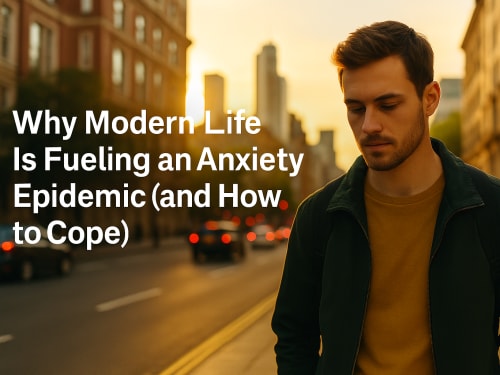The Psychology of Modern Anxiety: Why We’re All Feeling More Stressed

posted 8th October 2025
🌿 The Psychology of Modern Anxiety: Why We’re All Feeling More Stressed
In 2021, it was reported that 359 million people worldwide were living with anxiety disorders (World Health Organisation, 2023). From racing thoughts and sleepless nights to that constant knot in your stomach, anxiety has quietly become part of modern life.
We’re juggling too much: work, money, social media, and a world that never seems to switch off. It’s no wonder so many of us feel on edge.
But here’s the thing: just because anxiety is common doesn’t mean it’s normal. It’s time to ask why we’re all so stressed, and what we can actually do about it.
💭 What Are Anxiety Disorders?
There isn’t just one kind of anxiety; there are many, each affecting people in different ways. Anxiety disorders are more than just feeling worried or stressed; they involve persistent fear, tension, or worry that can interfere with daily life.
Some of the most common include:
- Generalised Anxiety Disorder (GAD)– Constant, uncontrollable worry about everyday things like work, health, or relationships.
- Panic Disorder– Sudden waves of intense fear, often with physical symptoms like a racing heart, sweating, or shortness of breath.
- Social Anxiety Disorder– An overwhelming fear of being judged or embarrassed in social situations.
- Phobias– Intense, irrational fears of specific things such as heights, flying, or spiders.
- Obsessive-Compulsive Disorder (OCD)– Repetitive thoughts and behaviours that feel impossible to control.
- Post-Traumatic Stress Disorder (PTSD)– Anxiety that develops after experiencing or witnessing a traumatic event.
Each disorder looks different, but they all share one key feature: anxiety that feels disproportionate, intrusive, and difficult to manage.
🧠 The Cognitive Theory of Anxiety
According to psychologist Aaron Beck, one of the founders of cognitive therapy, anxiety isn’t just about what happens to us — it’s about how we think about what happens.
Beck’s Cognitive Theory of Anxiety suggests that anxious individuals tend to interpret situations as more dangerous or threatening than they really are.
For example:
- Someone with social anxiety might think, “Everyone’s going to judge me if I speak up.”
- A person with panic disorder might believe, “If my heart races, I’m having a heart attack.”
These thoughts trigger fear, which reinforces anxiety — creating a vicious cycle of worry and avoidance.
Beck called these distorted patterns cognitive biases — automatic, often negative thoughts that exaggerate threats and underestimate our ability to cope. Over time, they make the world feel unsafe, even when it isn’t.
The positive side? Beck’s theory led to the development of Cognitive Behavioural Therapy (CBT) — one of the most effective, evidence-based treatments for anxiety.
💬 How CBT Helps Manage Anxiety
CBT is based on a simple but powerful idea: if you can change how you think and respond, you can change how you feel.
It teaches people to identify unhelpful thinking patterns — such as catastrophizing or assuming the worst — and challenge them with evidence.
“What proof do I have that something bad will actually happen?”
Over time, individuals learn to replace fear-driven thoughts with more balanced and realistic ones. CBT also includes exposure techniques, where people gradually face their fears instead of avoiding them. This process helps rewire the brain’s fear response, leading to less anxiety and greater confidence.
✨ The best part? CBT doesn’t just treat anxiety — it builds lifelong skills for resilience and self-regulation.
📊 What the Research Shows
Anxiety disorders are now the most common mental health condition globally, affecting more than 300 million people (World Health Organisation, 2023).
A 2024 meta-analysis found that global anxiety rates have increased by 25% since the pandemic, with the steepest rise among young adults (Santabárbara et al., 2024).
In the UK, surveys reveal thatone in six adultsnow experiences moderate to severe anxiety symptoms each week (Mind, 2023). These numbers reflect a growing reality — modern life is fast, uncertain, and often overwhelming.
🌿 Managing Anxiety in Everyday Life
While therapy is effective, small daily habits also make a huge difference. Here are practical, psychologist-approved strategies that help reduce anxiety:
- 🌬 Challenge your thoughts
Notice when your mind jumps to the worst-case scenario. Ask yourself: “Is this really true, or is it my anxiety talking?”
- 🧘 Practice mindfulness
Breathing exercises, meditation, or simply slowing down can calm your nervous system and bring you back to the present.
- 📵Limit digital overload
Take regular breaks from social media and notifications — your mind needs rest as much as your body does.
- 🚶Stay active
Exercise releases endorphins, boosts mood, and improves sleep. Even a 20-minute walk can ease tension.
- 💬 Connect with others
Sharing how you feel with friends, family, or a therapist can help lighten your emotional load and offer a fresh perspective.
- ⏰ Build steady routines
Regular sleep, meals, and downtime keep your body and mind in sync, reducing stress reactivity.
🗨️ When to Seek Professional Support
If anxiety is affecting your sleep, concentration, or daily life, it’s time to reach out for support. Evidence-based therapies such as CBT, mindfulness-based approaches, and counselling can make a real difference.
You don’t have to face anxiety alone; speaking to a qualified psychologist can be the first step toward feeling calmer and more in control.
📚 References
World Health Organization. (2023). Depression and other common mental disorders: Global health estimates. WHO Press.
Santabárbara, J., Ozamiz-Etxebarria, N., Idoiaga Mondragon, N., Bueno-Notivol, J., & Gorrotxategi, M. (2024). Global prevalence of anxiety and depressive symptoms after the COVID-19 pandemic: A meta-analysis. Frontiers in Psychology, 15(3). https://doi.org/10.3389/fpsyg.2024.1256789
Mind. (2023). Mental health statistics: Anxiety and stress in the UK. Retrieved from https://www.mind.org.uk





